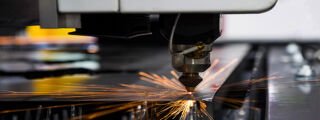This knowledge transfer partnership (KTP) with Birmingham-based company C Brandauer & Co Ltd investigates tool wear, which leads to substantial costs and tool downtimes.
Researchers
- Dr Shiva Babu
- Prof Michael Ward
- Prof Michal Krzyzanowski
Research background
Funded by Innovate UK, this knowledge transfer partnership was formed in late 2016. Brandaeur, one of the largest contract presswork and stampings companies in Europe, wanted assistance with tool wear.
Tool wear is a dynamic process, which is affected by geometry of punch and die, material properties and other process factors. Tool wear contributes to a substantial cost towards manufacturing of the tools. In addition, excessive tool wear leads to substantial tool downtimes.
The estimation of tool wear is important for scheduling tool changes and for process control and optimisation.
Research aims
In this project, punch wear and die wear is studied individually and their impact on the part characteristics is investigated in detail. Additionally, the influence of the different punch and die materials on the tool wear has been examined and discussed.
Outcomes of the project demonstrated that the project had a significant positive impact on the operations of the company such as reduction in maintenance cost and time by almost 26 percent.
Additionally, tool run increased from 1m to 3m between maintenance cycles. New orders for the plumbing sector was increased by four percent.
Processes such as costing, punch and die development and key parameters were standardized. The project outputs aligned with the real world activities have been proved very effective.
How has the research been carried out?
LS-Dyna was used for both modelling tool wear and prediction of worn tool geometry. It was proposed to utilize the capability to predict the tool life. The project utilized the resources available within the company to perform all the required experiments and also utilize the outcomes of the project on actual production runs.
Microscopic examinations of punches and dies has been performed using SEM. Various scientific journals and technical books were accessed at knowledge base partners to improve the understanding of the process. Access to industry experts in stamping and academic experts in numerical modelling helped to appropriately adjust the simulation model and improve understanding regarding the stamping process.
Research outcomes
All the findings from the project have been reported to the company managers and lead engineers to be utilized for development of new tools. Training for the company personnel has been provided to utilize the automated wear calculation and worn tool geometry reconstruction module for new product development. Training has also been provided to technical sales manager, engineering manager, apprentices to utilize the Brandauer new tool costing and quoting module for generation of new tool costings and customer quotes.
Additionally, a detailed user guide has been developed and documented.
The main outcomes of the project have been reported at METAL FORMING 2018 - 17th International Conference on Metal Forming (September 16-19, 2018, Toyohashi, Japan) and published:
- Babu S.S.M., Berry S., Ward M. and Krzyzanowski M.: Numerical investigation of key stamping process parameters influencing tool life and wear, Procedia Manufacturing, Vol. 15, 2018, pp. 427-435. https://www.sciencedirect.com/science/article/pii/S235197891830934X
